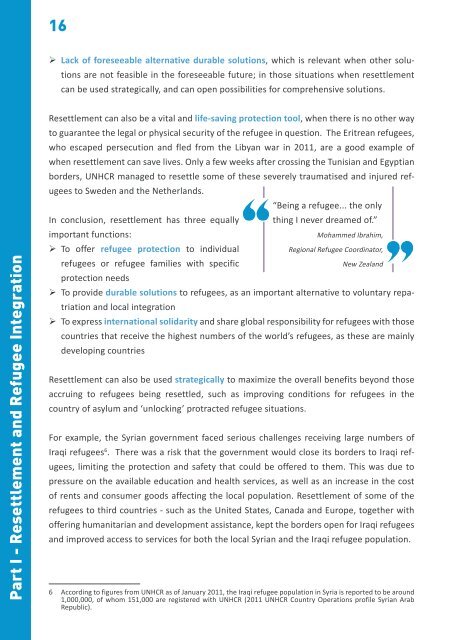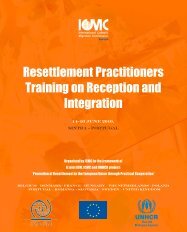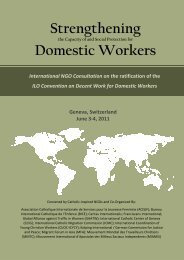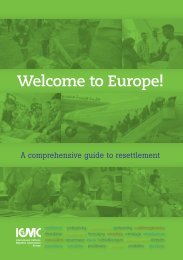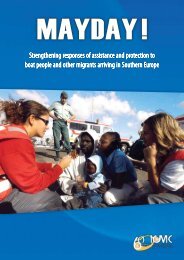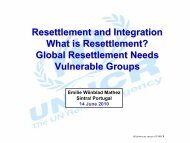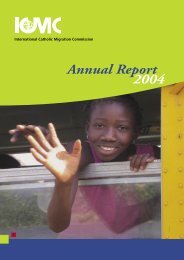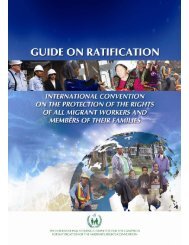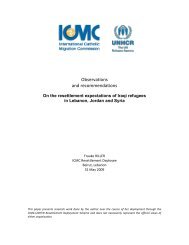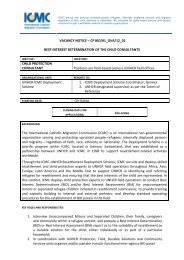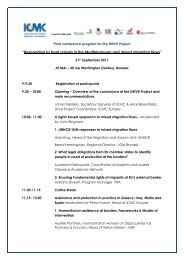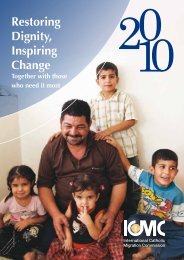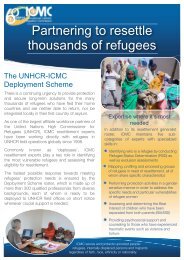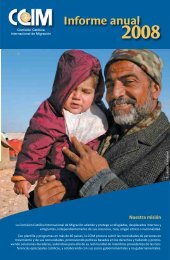'Paving the Way' Handbook - ICMC
'Paving the Way' Handbook - ICMC
'Paving the Way' Handbook - ICMC
Create successful ePaper yourself
Turn your PDF publications into a flip-book with our unique Google optimized e-Paper software.
16<br />
‣ ¾ Lack of foreseeable alternative durable solutions, which is relevant when o<strong>the</strong>r solutions<br />
are not feasible in <strong>the</strong> foreseeable future; in those situations when resettlement<br />
can be used strategically, and can open possibilities for comprehensive solutions.<br />
Part I - Resettlement and Refugee Integration<br />
Resettlement can also be a vital and life-saving protection tool, when <strong>the</strong>re is no o<strong>the</strong>r way<br />
to guarantee <strong>the</strong> legal or physical security of <strong>the</strong> refugee in question. The Eritrean refugees,<br />
who escaped persecution and fled from <strong>the</strong> Libyan war in 2011, are a good example of<br />
when resettlement can save lives. Only a few weeks after crossing <strong>the</strong> Tunisian and Egyptian<br />
borders, UNHCR managed to resettle some of <strong>the</strong>se severely traumatised and injured refugees<br />
to Sweden and <strong>the</strong> Ne<strong>the</strong>rlands.<br />
“Being a refugee... <strong>the</strong> only<br />
In conclusion, resettlement has three equally thing I never dreamed of.”<br />
important functions:<br />
Mohammed Ibrahim,<br />
‣ ¾ To offer refugee protection to individual<br />
Regional Refugee Coordinator,<br />
refugees or refugee families with specific<br />
New Zealand<br />
protection needs<br />
‣ ¾ To provide durable solutions to refugees, as an important alternative to voluntary repatriation<br />
and local integration<br />
‣ ¾ To express international solidarity and share global responsibility for refugees with those<br />
countries that receive <strong>the</strong> highest numbers of <strong>the</strong> world’s refugees, as <strong>the</strong>se are mainly<br />
developing countries<br />
Resettlement can also be used strategically to maximize <strong>the</strong> overall benefits beyond those<br />
accruing to refugees being resettled, such as improving conditions for refugees in <strong>the</strong><br />
country of asylum and ‘unlocking’ protracted refugee situations.<br />
For example, <strong>the</strong> Syrian government faced serious challenges receiving large numbers of<br />
Iraqi refugees 6 . There was a risk that <strong>the</strong> government would close its borders to Iraqi refugees,<br />
limiting <strong>the</strong> protection and safety that could be offered to <strong>the</strong>m. This was due to<br />
pressure on <strong>the</strong> available education and health services, as well as an increase in <strong>the</strong> cost<br />
of rents and consumer goods affecting <strong>the</strong> local population. Resettlement of some of <strong>the</strong><br />
refugees to third countries - such as <strong>the</strong> United States, Canada and Europe, toge<strong>the</strong>r with<br />
offering humanitarian and development assistance, kept <strong>the</strong> borders open for Iraqi refugees<br />
and improved access to services for both <strong>the</strong> local Syrian and <strong>the</strong> Iraqi refugee population.<br />
6 According to figures from UNHCR as of January 2011, <strong>the</strong> Iraqi refugee population in Syria is reported to be around<br />
1,000,000, of whom 151,000 are registered with UNHCR (2011 UNHCR Country Operations profile Syrian Arab<br />
Republic).


